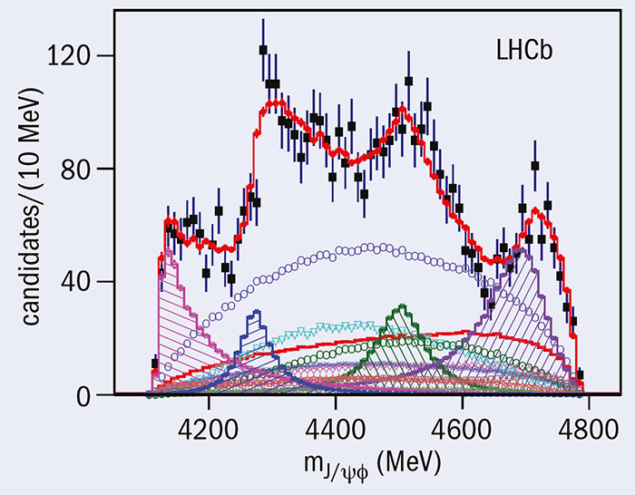A report from the LHCb collaboration
The LHCb collaboration has reported the observation of three new exotic hadrons and confirmed the existence of a fourth by analysing the full data sample from LHC Run 1. Although the theoretical interpretation of the new states is still under study, the particles each appear to be formed by two quarks and two antiquarks. They also do not seem to contain the lightest up and down quarks, which means they could be more tightly bound than other exotic particles discovered so far.

Until recently, all observed hadrons were formed either by a quark–antiquark pair (mesons) or by three quarks only (baryons). The underlying reason has remained a mystery, but during the last decade several experiments have found evidence for particles formed by more than three quarks. For example, in 2009 the CDF collaboration at Fermilab in the US observed evidence for a tetraquark candidate dubbed X(4140), which was later confirmed by the CMS and D0 collaborations (the latest LHCb analysis yields a clear observation of this state, although finds a slightly larger width than the other experiments). Then, in July 2015, LHCb announced the first observation of two pentaquark particles, which are hadrons composed of five quarks.
Each of the four states observed by LHCb – dubbed X(4274), X(4500) and X(4700), in addition to the X(4140) – has a statistical significance above five standard deviations. Sophisticated analysis of the angular distribution of B+ meson decays into J/ψ, φ and K+ mesons also allowed the collaboration to determine the quantum numbers of the exotic states with high precision. Alas, the data could not be described by a model that contains only ordinary mesons and baryons.
The binding mechanism of the new states could involve tightly bound tetraquarks or strange charmed meson pairs bouncing off each other and rearranging their quark content to emerge as a J/ψφ system. The high statistics of the LHCb data set and the sophisticated techniques exploited in the analysis will help to shed further light on the production mechanisms of these particles.
LHCb has made several other important contributions to the investigation of exotic particles. In February 2013, the quantum numbers of the X(3872) particle discovered in 2003 by the Belle experiment in Japan were determined, and in April 2014 the collaboration showed that the Z(4430) particle (also discovered at Belle) is composed of four quarks: ccdu. The latest exotic results from LHCb, which were first presented in June at the Meson 2016 workshop in Cracow, Poland, have been submitted for publication.
Further reading
LHCb Collaboration 2016 arXiv:1606.07895, submitted to Phys. Rev. Lett.
LHCb Collaboration 2016 arXiv:1606.07898, submitted to Phys. Rev. D.





